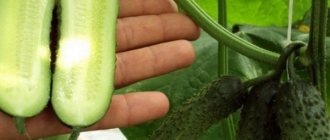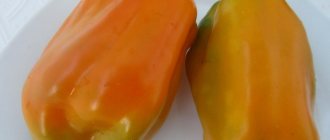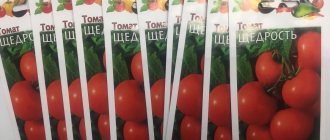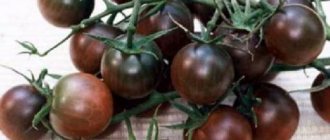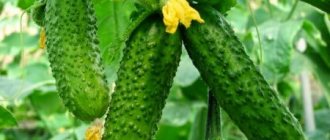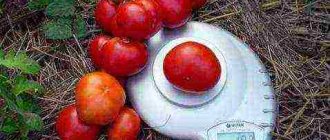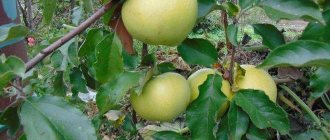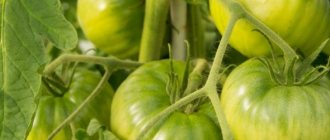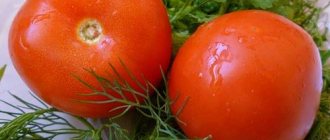Author's rating
Author of the article
Yakov Pavlovich
Professor, Head of the Department of Vegetable Growing
Articles written
153
Many amateur gardeners, who do not have the opportunity to devote all their free time to work on the site, choose the tomato series non-sapling. The compact crown of these plants does not need to be formed, which eliminates a significant part of the care. This variety includes mainly standard low-growing varieties. Their undeveloped side shoots can be left unpinched without damaging the crop. Caring for such tomatoes is simple and does not take much time.
Watercolor
forum.vinograd.info
Mid-season variety for open ground. It is unpretentious and bears fruit consistently regardless of weather conditions. The peculiarity of Watercolor is the formation of heavy brushes strewn with bright red “cream” with dense skin and pulp. The weight of one fruit can reach 100 g, and the average yield is 6-8 kg per 1 sq.m. The bushes do not need a garter. The taste of the tomatoes is very good. If necessary, the fruits can be left to ripen; they are also excellent for canning. The variety is resistant to blossom end rot and fruit cracking.
Tips and tricks
Buy seeds in trusted, specialized stores. Pay attention to the packaging. It must indicate the variety, manufacturer, number of seeds, and date of manufacture.
To get a good harvest, caring for plants is necessary, despite their unpretentiousness. Nepas series varieties are left unattended for 1-2 weeks in favorable weather, but it is important to ensure watering once every ten days.
The bushes need to be tied up, weeded, the soil loosened, and fed every two weeks.
The basic agrotechnical methods are the same as for other varieties, with the exception of pinching and bush formation.
Aztec
selcdn.com
Ultra-early variety for open ground, greenhouses, balconies or winter gardens. The height of the bush does not exceed 40 cm, and the weight of the fruit is 20-30 g. Aztec forms many ovaries and is usually covered with bright yellow tomatoes. They taste sweet and tender! A real delicacy that can be eaten straight from the bush, added to a salad or canned. To make the plant feel good, choose a sunny place for it. In a greenhouse, tomatoes will bear fruit until frost.
Rules of care
Tomatoes that do not vine are watered abundantly, but not too often, depending on the condition of the soil and the amount of precipitation. At the end of flowering, the frequency of watering is reduced, stimulating the process of fruit formation. After watering, it is useful to loosen, especially if the soil is heavy.
Expert opinion
Stanislav Pavlovich
Gardener with 17 years of experience and our expert
Ask a Question
Important! 10 days after planting, the plants are earthed up, which activates root growth. After another month, the hilling is repeated. For non-grasping varieties, it is better to choose drip irrigation or watering into furrows.
During the period of green mass growth, nitrogen fertilizers are a suitable fertilizer for tomatoes. When the period of fruit formation begins, fertilizers based on potassium and phosphorus are applied. In total, three feedings are made:
- feed for the first time 10 days after planting;
- the second time - with the beginning of the formation of buds;
- The third feeding is timed to coincide with the blooming of the third cluster.
See also How to grow Tamarillo fruit in open ground
You can feed the plantings with liquid complex fertilizers such as “Ideal” or a solution of bird droppings (1 to 15).
There is a way to grow tomatoes in boxes - beds enclosed in wooden walls. Arches with covering material are installed above such a bed. This helps to protect the plantings from the external environment, extend the growing season, and achieve a longer harvest period. The soil in the garden bed is fertilized with organic residues, which provide additional heat when rotting. In such conditions, tomatoes are grown directly from seeds.
All non-sprouting tomatoes are low and do not require crown formation. During the period of fruit formation, it is better to tie up the bushes to prevent lodging.
In open ground, plants are pollinated by wind and insects. When grown in greenhouses, the bushes are pollinated by hand with gentle shaking, and the brushes are treated with fruit formation stimulants Bud and Ovary. Complex fertilizers also stimulate pollination.
Danko
fermoved.ru
Mid-season variety with red, heart-shaped fruits. From one bush you can collect about 3 kg of such “hearts” weighing 100-300 g, and in a greenhouse you can grow specimens up to 500 g. The taste of the fruit is excellent, but the skin is quite thin, so it is especially good to use Danko for making juices, ketchups, lecho. A big plus is that the variety produces a stable harvest, regardless of weather conditions: it can cope with both the lack of sun and cold weather, although it cannot be called high-yielding. The variety has no special soil requirements.
Why do tomatoes grow?
Tomatoes are usually planted to increase yield. If you do not do this, you will end up with a powerful, branched bush, and you will harvest very few fruits, since the plant will devote all its energy to maintaining the green mass. When the stepsons are removed in a timely manner, the opposite happens: all the nutrients go to the main inflorescences, and then to the fruits.
A side branch is called a stepson, which is formed in the axil between the leaf and the trunk. It is very similar to the leaf itself. This is exactly what beginners are afraid of: if I remove it, what if it’s a tomato leaf that is important for the bush?
Important! The stepson is formed after the formation of a full-fledged leaf. A small but fast-growing shoot appears in the corner between the stem and the adult leaf. This is what needs to be removed.
In addition to increasing the yield, timely removal of stepsons promotes faster ripening of fruits. Red tomatoes appear one and a half to two weeks earlier.
Dubok (Dubrava)
yagodka.club
An early-ripening, unpretentious variety that has earned the love of many tomato growers. Suitable for greenhouses and open ground. The fruits ripen quickly and evenly, have an excellent taste with a slight sourness and tolerate transportation well. On average, one fruit weighs up to 100 g. Productivity is 6-8 kg per 1 sq.m. Tomatoes of the Dubok variety easily tolerate unfavorable weather conditions: drought or frequent rains rarely harm the crop. The bush should be formed into 3-4 stems. If necessary, it is worth gartering, but the variety does not require pinching.
How to do stepsoning
The most suitable time for pinching and breaking out leaves is the first half of a sunny, warm day. By evening, the wound will have dried out, which will reduce the possibility of infection.
Before you start pinching, you need to complete the formation of the bush, it doesn’t matter whether they are ordinary tomatoes or tomato varieties that do not require pinching. Indeterminate (tall) bushes usually have 1 stem, and in determinate (low) bushes 2-3 stems. It is enough to do this work just once after the first ovary appears. You will have to plant the stepson all the time while the plant is growing.
Attention! According to the advice of experienced gardeners, it is more convenient not to trim the stepchildren using tools, but to break them off with your hands.
In order to prevent the stepson from appearing again, have time to remove it at the right time, that is, when it grows to 5-7 cm. But most importantly, do not remove it completely, but leave a stump of about 2 cm. It simply will not allow a new stepson to form, since the place is already taken.
Nepas (Non-following)
pbs.twimg.com
An early ripening variety, the name of which eloquently indicates that the bushes do not require pinching. The fruits of Nepas are very juicy, round, and have a high content of vitamins. The weight of one tomato is 50-80 g. From 1 square meter you can collect 5-6 kg of fruit. The variety is unpretentious and will tolerate even cold or dry weather.
There is also a whole series of Nepas tomatoes with a wide variety of characteristics!
Nepas 2 (Nepaceous crimson). The fruits are red-crimson, round, smooth, weighing 75-100 g.
Nepas 3 (Nepasny pink). The fruits are fleshy, round, weighing 110-140 g.
Nepas 4 (Nepasynuschiy orange heart-shaped). The fruits are dense, sweet, and contain a lot of beta-carotene. The weight of one fruit is 60-70 g.
Nepas 5 (Nepasynkuyu orange with a “spout”). Fruits with thick skin and high carotene content, weighing 60-80 g.
Nepas 7 (Nepasny giant). Round, red fruits weighing 150-200 g, have excellent taste.
Nepas 8 (Nepasny carrot). Cylindrical, with a “spout”, red and glossy, weighing 50-70 g.
Nepas 9 (Non-piston extended). The fruits are cylindrical with a “spout”, weighing 50-60 g. Very tasty and do not crack.
Nepas 10 (Non-striped striped). Oval, crimson fruits with thin yellow stripes weighing 70-80 g.
Nepas 11 (Non-stepping indoor). Small, sweet, red fruits weighing 20 g.
Nepas 12 (Non-passing large). Round, red fruits weighing 100-150 g.
Nepas 13 (Nepaceous plum-shaped). Red, glossy tomatoes weighing 70-90 g. Thanks to their thick skin, they do not crack.
Nepas 14 (Non-grazing sugar). Flat-round, red fruits with a very sweet taste. Weight – 80-100 g.
conclusions
Pinching (pinching a tomato) is an important part of caring for tomato bushes. If this procedure is not carried out, all the minerals and water necessary for the formation of the crop will be spent on the development of greenery. Numerous varieties have been developed that do not require removal of shoots or leaves, i.e. may not take steps. These are almost always low-growing plants with early or mid-early ripening. When choosing seed material, it is important to take into account not only the characteristics of cultivation, but climatic conditions.
Read about the proper cultivation of tomatoes in open ground in this material.
Low-growing, non-sprouting tomato varieties are in particular demand among beginning gardeners, since they do not require the formation of a bush. The range of such varieties is wide: Carrot, Tayana, Mongolian dwarf, Yamal, Metelitsa and others.
However, breeders continue to work on creating new varieties. So, in 2017-2018. The state register has been replenished with a whole group of non-grafting tomatoes - Nepas (Nepas, Nepas 2, Nepas 3, Nepas 4, Nepas 7, Nepas 9, Nepas 12).
Shuttle
green-color.ru
An early-ripening, high-yielding variety, characterized by a long fruiting period and unpretentiousness. The shuttle tolerates cold well, so it is more suitable for growing in open ground. But diseases can cause significant damage to it, so it is worth regularly inspecting the bushes and, if necessary, carrying out treatment. The bushes are standard, erect, 45-50 cm high. They branch weakly, so they do not need pinching or staking. From 1 square meter on average you can harvest up to 8 kg of dark red tomatoes weighing about 70 g. They taste juicy, with a sweetish aftertaste. The skin is quite dense. The fruits are suitable for all types of canning.
Don't like shaping tomato bushes? Be sure to try growing the varieties described above. And if growing tomatoes is your favorite hobby and you strive for excellent results, about
Features of cultivation
Tomatoes of the Nepas series are called a “weekend” crop. The rules of agricultural technology for breeding them are so simple that with minimal human intervention they feel good and actively bear fruit.
Seeds are sown for seedlings 2 months before planting in the ground, and in regions with a warm climate, a non-seedling growing method is also allowed. The optimal period is March or April, depending on the climate. After soaking in a pale solution of manganese, they are sown in containers with a fertile mixture and covered under film until germination. After the cotyledon leaves appear, they are transplanted (dive) into cups, providing abundant lighting. Two weeks before the time for planting in the ground comes, hardening is carried out in the fresh air (at a temperature of +15°C and bright sun).
When organizing beds, choose turf or loamy soil, to which ash and humus are added and enriched with nitrogen. They use the method of growing tomatoes in buckets. In them, the soil warms up quickly, and the nutrients are fully used by the plant. Such beds can be moved around the site, and, in bad weather, brought indoors. Before starting planting work, holes are punched in the bottom for moisture and drainage made of broken bricks is laid on the bottom.
